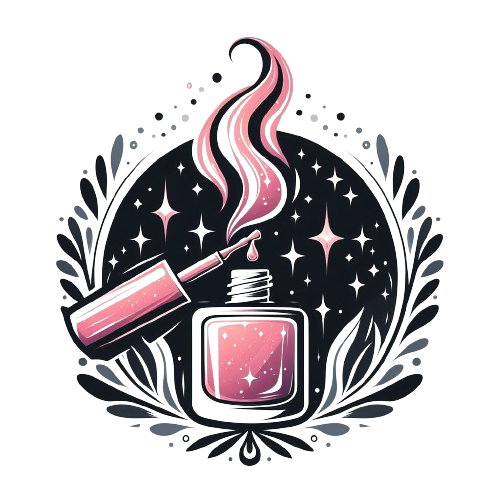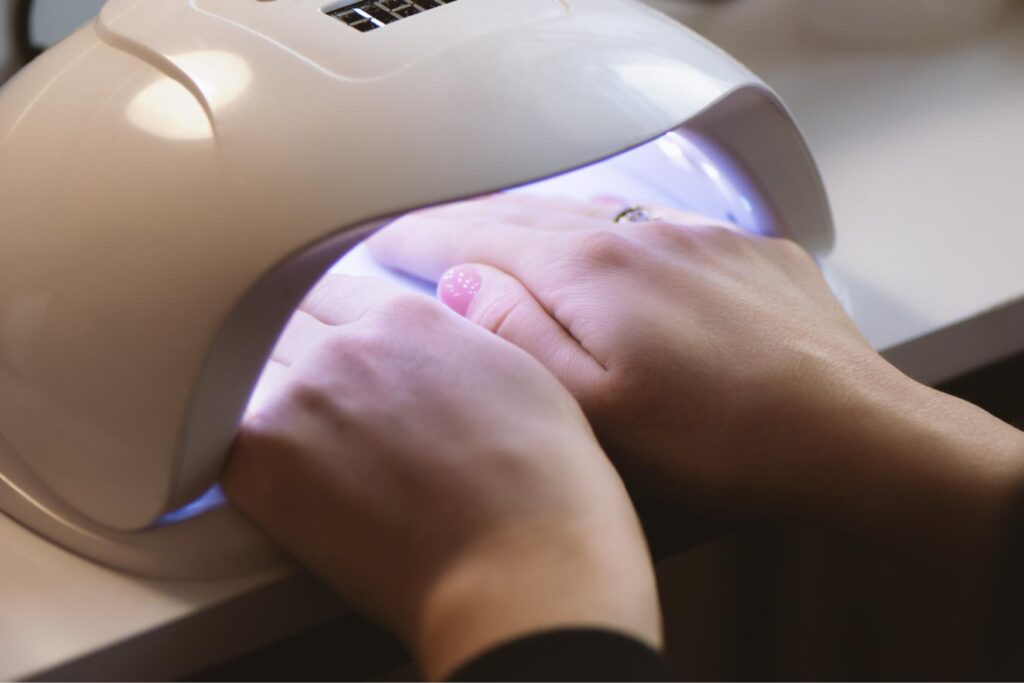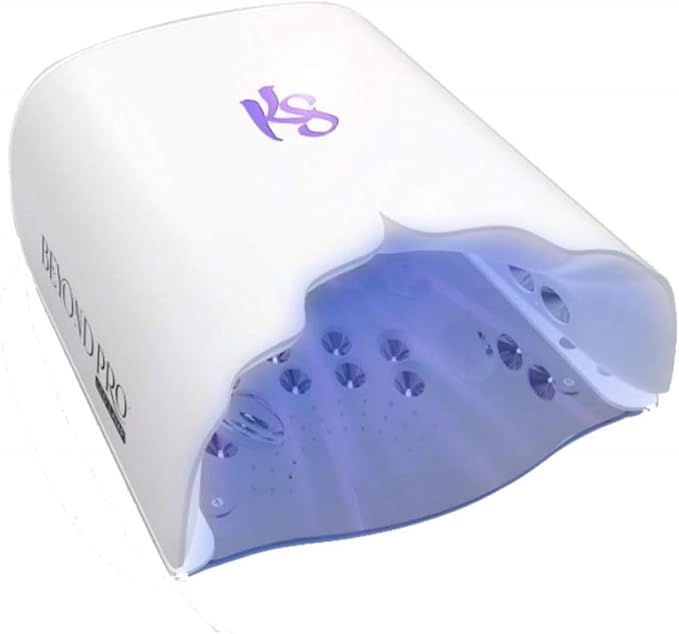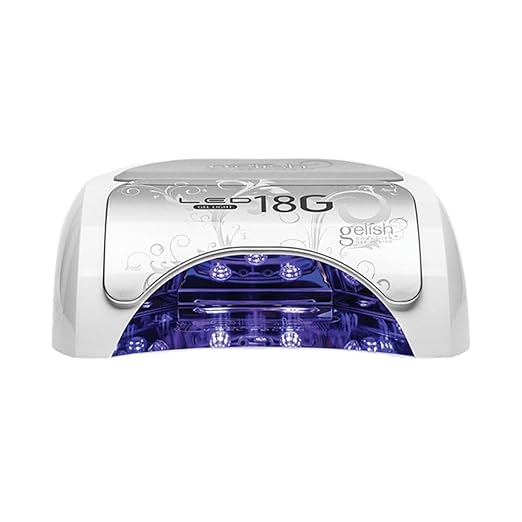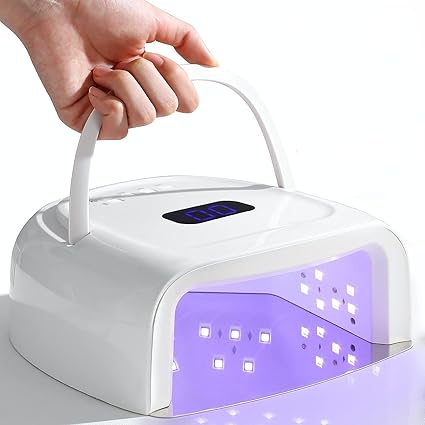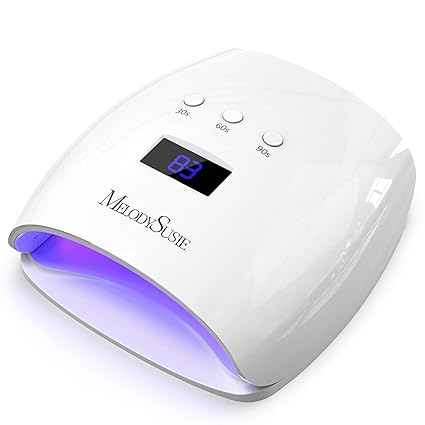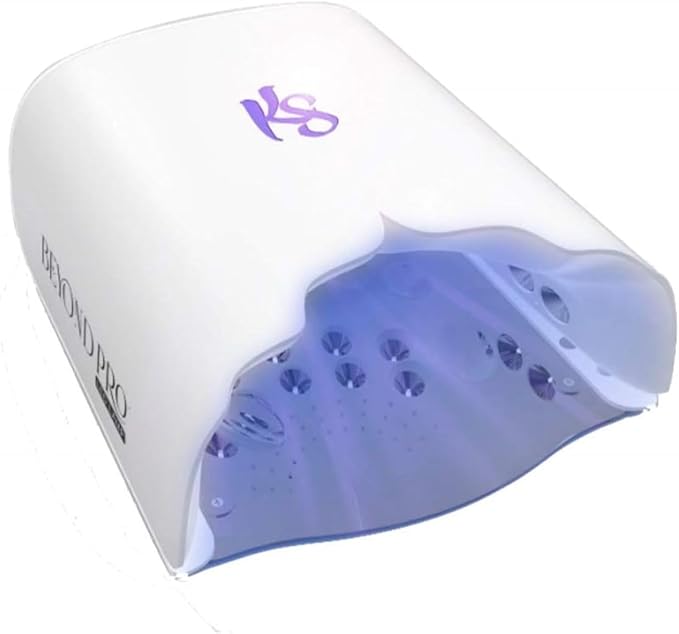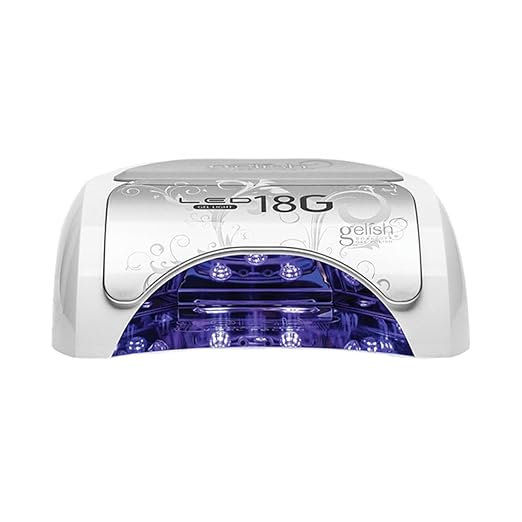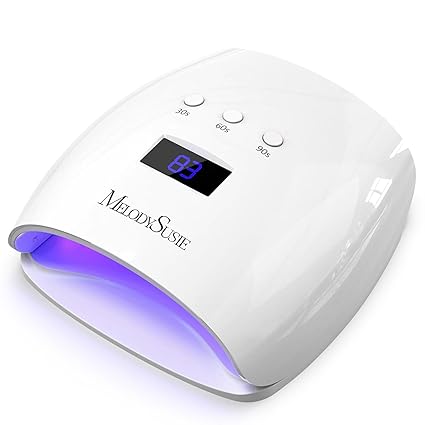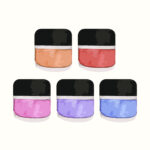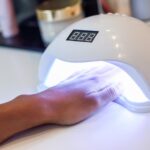This article contains affiliate links, which means we may earn a commission if you make a purchase through these links, at no extra cost to you.
Having the right UV nail curing lamp can be a game changer for DIY manicures and salon treatments alike. Whether you’re new to gel nails or have been curing dozens of sets for years, a quality lamp will make all the difference.
In this friendly and in-depth guide, we’ll walk through why a good UV lamp matters, how these nail curing lights work, and what to look for before you buy one.
We’ll cover the differences between UV and LED lamps, key factors like wattage, timers, and size, and discuss who each type is best for.
We’ll also explore popular lamp categories, safe usage tips, curing times, removal methods, and maintenance advice. Let’s get started on finding the ideal nail lamp for your needs!
Why a Good UV Lamp Matters
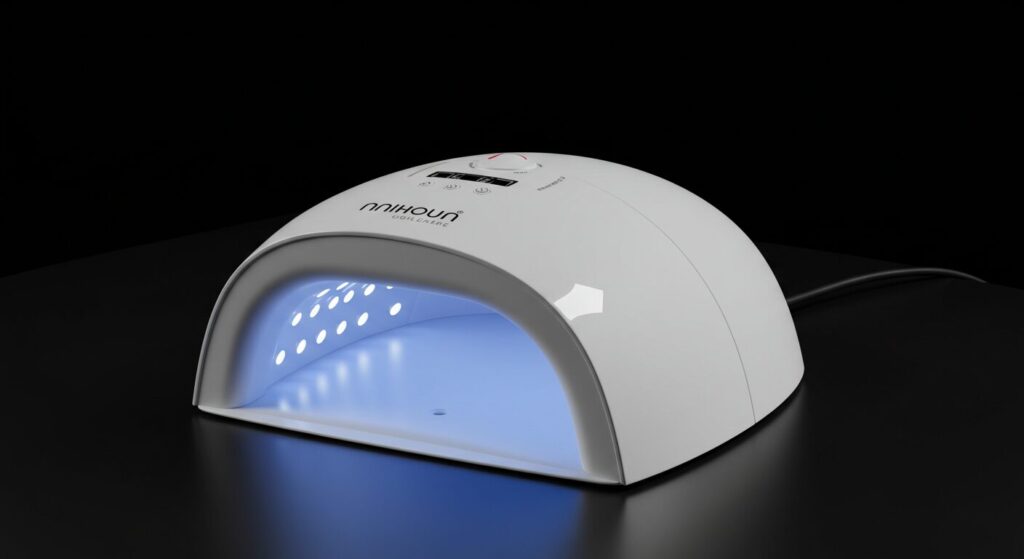
A high-quality UV nail lamp is much more than a pretty piece of equipment – it’s the difference between a durable, salon-worthy gel mani and one that chips or lifts too soon.
The main job of a UV lamp (or nail dryer) is to fully cure gel polish or gel extensions. If the lamp doesn’t evenly distribute the right intensity of UV light, the gel may stay tacky, peel off early, or even cause skin irritation. Consistent curing ensures your polish looks smooth, glossy, and professional.
Another reason a reliable lamp is essential is efficiency. A powerful lamp can cure nails faster, saving you time.
This is important whether you’re a salon professional handling multiple clients or an at-home user who wants a speedy mani.
Plus, using a lamp with accurate timers and sensors can help you avoid under-curing (which weakens your gel) or over-curing (which can make nails brittle over time).
In short, a good UV lamp helps your gel polish last as long as possible while keeping your nails healthy.
What Are UV Nail Curing Lamps and How Do They Work
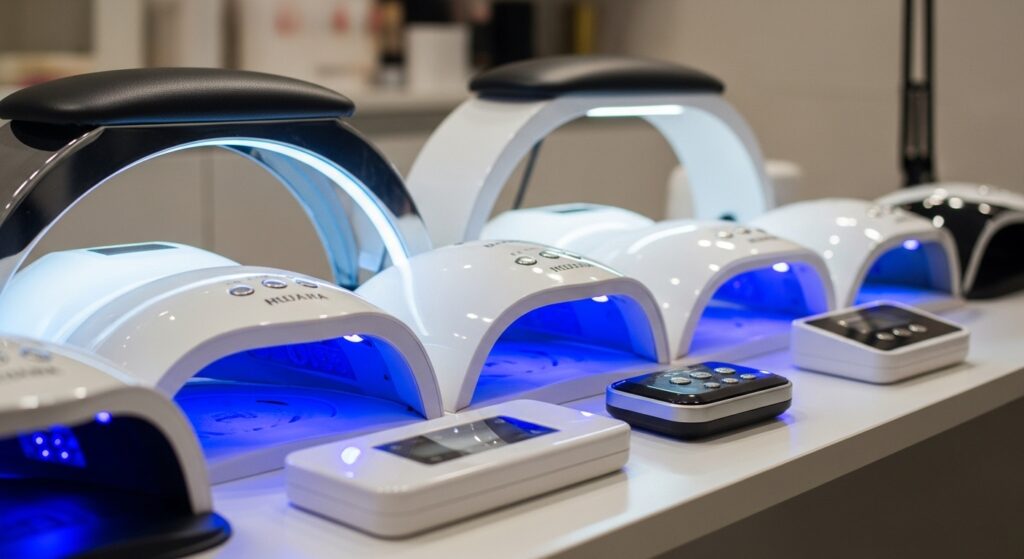
UV nail curing lamps (sometimes called nail dryers or nail lamps) are devices that emit ultraviolet light to harden or “cure” gel-based nail products. Gel nail polish, builder gels, and other hard-setting nail products contain special chemical photo-initiators.
When these photo-initiators are exposed to UV or LED light at specific wavelengths, a chemical reaction occurs that instantly hardens the gel. Without this light, gel polish would never properly set and would remain wet or tacky.
Traditionally, UV lamps used fluorescent bulbs that emit a broad spectrum of ultraviolet light (mostly UVA, which is in the 315–400 nm range).
Modern LED lamps use light-emitting diodes that produce a narrower band of UV light, typically around 365 nm or 405 nm. Some lamps combine both UV and LED diodes (often labeled “UV/LED lamps”) to ensure they work with all types of gel polish.
Whichever the light source, the principle is the same: shine the correct light on the gel to trigger that curing reaction.
Most nail lamps have a compartment where you place your hand (or foot) under a hood of lights. Inside, reflective surfaces help spread the light evenly across all the nails.
The lamp will have a power button or switch and usually a timer dial or digital display.
You set the timer for the recommended cure time (say, 30 or 60 seconds), press start, and the lamp’s lights come on to harden your polish.
When time is up, an alarm may sound or the light simply turns off, signaling the cure is done.
Once each gel layer is cured, the polish is set and ready for the next step.
This process is repeated for the base coat, color coats, and final top coat until your manicure is finished.
UV vs LED Lamps: What’s the Difference?
Modern nail lamps are often called UV, LED, or UV/LED lamps, depending on their light source. Here’s how they differ:
- Light Source & Spectrum: Traditional UV lamps use fluorescent bulbs that emit a broad UVA spectrum (around 365 nm). LED lamps use diodes that emit a narrower range of UV/near-UV light (often around 405 nm). Many gel polish formulas today are optimized for LED lamps, but some older or specialty formulas need UV light. For maximum compatibility, UV/LED combo lamps include both types of bulbs.
- Curing Speed: LED lamps generally cure gel polish faster. A typical LED lamp (36W–48W) can cure one coat in about 30–60 seconds. Traditional UV lamps often need 90–120 seconds for the same coat. (Exact times depend on the lamp’s wattage and the gel formula.)
- Bulb Life: Fluorescent UV bulbs last around 1,000–2,000 hours (meaning they may need replacing every few months of heavy use). LED bulbs last much longer – often 10,000+ hours. In practice, an LED lamp can last years of regular use without changing bulbs.
- Heat Output: Both lamp types generate some heat on your nails. LED curing sessions can feel warm or stingier in short bursts, while UV bulb lamps warm up more gradually. Some lamps offer a “low heat” mode to ease discomfort on sensitive nails.
- Compatibility: Most modern gels work with either UV or LED. However, some LED-only gels will not cure correctly under UV light, and vice versa. Using a UV/LED combo lamp is the safest bet if you switch between different gel brands. It ensures any gel polish or builder gel will cure fully.
In summary, LED lamps cure faster and their bulbs last longer, while UV lamps were the original standard that still cure all types. Today, many people choose a UV/LED combo lamp for the best of both worlds: fast curing times and broad gel compatibility.
Key Features to Look For
When choosing a UV/LED nail lamp, pay attention to these important specs:
- Wattage (Power): Lamps come in various power levels, often 24W, 36W, 48W or more. Higher wattage typically cures faster. For basic at-home use, a 24W–36W lamp is usually sufficient. Professional use might call for 48W+ for quicker cures and larger coverage. If the wattage is too low, curing times will be noticeably longer.
- Timer Settings & Controls: A good lamp has adjustable timers (commonly 30s, 60s, 90s) so you can match the polish instructions exactly. Many lamps have easy preset buttons and even a digital countdown display. An auto-off timer ensures the lamp turns off after the set time, preventing over-curing.
- Auto Sensor: Many modern lamps have built-in sensors that turn the light on as soon as you slide your hand in, and off when you remove it. This feature adds convenience and helps save power. If you’re doing both hands or working on nail art, a sensor lamp can make the process smoother.
- Size and Nail Fit: Make sure the lamp is large enough for your hand (and, if needed, a foot) comfortably. Some lamps cure one hand at a time; others fit both hands. A removable bottom tray is handy if you want to do toes as well. Check that all your fingertips and thumbs can reach the light without touching the lamp’s walls or bulbs.
- Portability (Optional): If you need to travel with your lamp or have limited space, consider a compact or cordless model. USB-powered or rechargeable lamps exist, but keep in mind they often have lower wattage (9W–24W) and may take longer to cure. Portable lamps are great for touch-ups on the go, though they won’t be as fast as a full-sized unit.
- Ease of Use: Look for intuitive controls and good displays. Clear LED/LCD displays, simple buttons, or preset timers make life easier. Some lamps even have memory functions or remote controls. The goal is a lamp that’s quick to set up and simple to operate.
- Build Quality: A well-built lamp will last longer. Sturdy plastic or metal housing, non-slip feet, and a stable power cord all contribute to durability. Check for safety certifications (CE, FCC, etc.) if you want extra peace of mind.
By comparing these features side by side, you can narrow down which lamp suits your needs. Remember that more features often mean a higher price, so focus on the ones that matter most for your nail routine.
Recommended Use: At-Home vs Professional
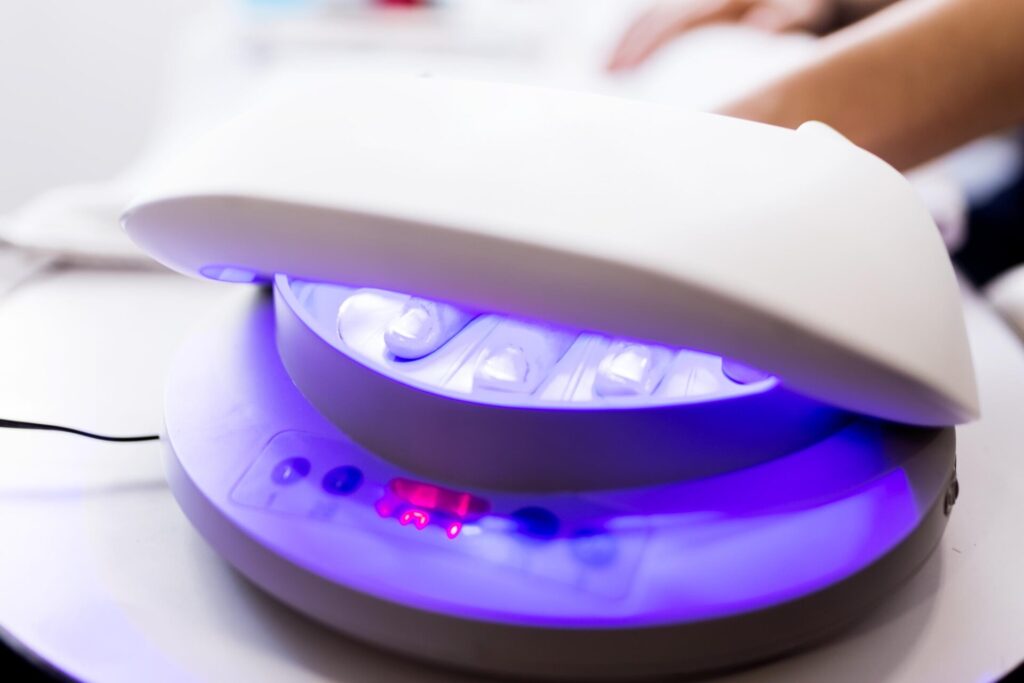
At-Home Users:
If you enjoy gel manicures at home for yourself, friends, or family, you’ll want a lamp that’s user-friendly and efficient without being overkill. A 24W–36W LED/UV lamp is usually enough power for curing one hand at a time.
At-home lamps tend to be compact and lightweight. Useful features include preset timers (30s, 60s), an auto-sensor, and easy-to-use controls.
Some models have a removable base for pedicures, which can be handy for curing toes. In general, at-home lamps focus on convenience and value. Steer clear of the very cheapest models, as they may cure unevenly or break sooner.
Professional/Salon Users:
For salon technicians and frequent users, speed and durability are paramount. Salon-grade lamps often have higher wattage (36W, 54W or more) and enough space to cure two hands (and usually a foot) at once.
These lamps are built to last: they usually have sturdy metal or thick plastic casings and non-slip feet. Professional lamps may offer advanced features like multiple timer modes, foot-pedal activation, adjustable power levels, or built-in cooling fans.
Safety certifications (CE, FCC, etc.) and a solid warranty are also desirable. In short, if you do nails daily for many clients, investing in a powerful, well-built lamp will make the job faster and easier.
Best Nail Curing Lamps
Popular Product Types
Below are some common categories of nail lamps to consider. We’ve left space for specific product highlights.
Salon-Grade UV/LED Lamps
Salon-grade nail lamps are built for frequent use. They usually have high wattage (often 48W or more) and a spacious interior, able to cure both hands (and a foot) at once. Look for sturdy construction and many timer settings.
Many salon lamps use both UV and LED bulbs to cure any gel formula quickly.
Compact At-Home Lamps
These lamps are designed for personal use. They often cure one hand at a time and have a moderate wattage (commonly 24W–36W).
Their smaller size makes them easy to store or travel with. Despite the size, good models still include timers and auto-sensors.
Portable Travel Lamps
Ultra-compact lamps for on-the-go users fall into this category. These might be USB-powered or battery-operated, and they cure nails more slowly due to lower power (9W–24W).
They’re great for quick touch-ups or vacations but aren’t as fast as full-size lamps.
Budget-Friendly Lamps
Budget-friendly lamps focus on value. They may have simpler designs (often plastic casing) and fewer features, but can still cure gel polish adequately.
Many are LED-only and around 24W. If cost is a concern, a budget lamp with good reviews can be a decent start.
Safe Usage Tips
Using a UV or LED lamp is generally safe if used properly. Follow these tips to protect your nails and skin:
- Use Sunscreen or Gloves: Apply a broad-spectrum SPF to the backs of your hands, or wear fingerless UV-protective gloves. This minimizes UV exposure to your skin.
- Follow Recommended Cure Times: Use the lamp’s timer or follow the product instructions for each gel coat. Avoid under-curing (which leads to peeling) or grossly over-curing (which can create heat on the nail bed).
- Protect Your Eyes: Avoid staring directly at the light. Even though modern lamps have shielding, it’s best to close your eyes or look away while curing.
- Low-Heat/Comfort Mode: If your lamp has a “low heat” or soft-start mode, use it for thick gels or sensitive clients. It gradually ramps up power to reduce the stinging sensation.
- Avoid Skin Contact with Bulbs: Keep your fingers and hands away from the lamp’s bulbs or inner walls. Position your hand so all nails are exposed to the light without touching the sides.
- Check Skin Sensitivity: If you notice redness, itching, or irritation around your nails after curing, try a different lamp or shorter cure times. Persistent problems may warrant a dermatologist’s advice.
Treat the lamp precautions just as you would any UV light source. With sensible use, your hands will be cured beautifully with minimal risk.
Typical Curing Times
Curing times can vary based on the lamp’s power and the gel formula, but here are general guidelines:
- LED Lamps (36W–48W): Most color coats and clear top/bottom coats will cure in about 30–60 seconds. Many modern gel polishes specify LED cure times around 30 seconds per coat.
- UV Lamps (24W–48W): With traditional UV bulbs, each coat usually takes about 90–120 seconds (1.5–2 minutes) to cure fully.
- Layers Matter: Always cure each layer separately—base coat, each color coat, and top coat each need curing. Do not stack multiple coats and cure only once at the end.
- Special Cases: Some thin glitters or nail art layers only need a quick “flash cure” of about 10–15 seconds to set them before applying the next coat or top coat.
If you’re unsure of your specific polish, it’s safer to cure a bit longer until you find the right timing for your lamp and product.
Removal Tips
Removing gel safely protects your natural nails. Here’s a common method:
- File Off the Gloss: Gently buff the shiny top coat with a nail file. This breaks the seal and lets remover penetrate.
- Soak with Acetone: Saturate a cotton ball with pure acetone or a gel polish remover. Place it on the nail, then wrap aluminum foil around each finger to hold the cotton in place.
- Wait 10–15 Minutes: Let the acetone work. After about 10 minutes, check one nail – if the gel is softening and lifting, proceed. If it’s still hard, rewrap and soak a few more minutes.
- Gently Remove Gel: Use a wooden cuticle stick or similar tool to softly push off the gel. It should come off easily. Never pry or force the gel off, as this can damage your nail.
- Buff and Moisturize: Once the bulk of the gel is removed, lightly buff any residue. Wash your hands, then apply cuticle oil and hand cream. Acetone is drying, so moisturizing is key to nail health.
Tip: For delicate nails, there are gel removal kits or acetone wraps that can simplify the process. Always be gentle—patience here keeps your nails strong.
Maintenance Advice
Keep your UV/LED lamp in good shape for consistent results:
- Clean It: After every few uses (or at least once a week), unplug the lamp and wipe the interior and sensor area with a dry, lint-free cloth. This clears away any dust or nail product residue.
- Replace UV Bulbs: If you have a fluorescent UV lamp, change the bulbs about every 6–12 months (roughly every 1000–2000 hours of use). Bulbs dim over time and cure less effectively. LED lamps do not require regular bulb changes.
- Check Power Cord: Periodically inspect the cord and plug for damage or wear. Unplug the lamp when not in use to be safe.
- Store Properly: Keep the lamp in a cool, dry place. Don’t spill acetone or other liquids on it, and avoid placing objects on top. Make sure any vents are clear and the lamp sits flat.
- No Water Contact: Never immerse the lamp in water or spray it with cleaner. Use only a dry cloth for cleaning to avoid electrical issues.
A little care goes a long way toward a lamp that performs reliably year after year.
Frequently Asked Questions
How long does it take to cure gel nails?
Typically, LED lamps cure each thin coat in 30–60 seconds and UV lamps in 90–120 seconds. Cure base coat, each color coat, and top coat separately.
The exact time depends on your lamp’s wattage and the gel brand. If unsure, start with 60 seconds and adjust as needed.
Is UV light safe for my nails and skin?
Generally, yes – the exposure from nail lamps is brief. Still, to minimize any UV exposure, you can apply sunscreen to your hands or wear UV-blocking gloves during curing.
The light from these lamps is mostly UVA, which is low-risk for short sessions. Avoid unnecessary exposure beyond what’s needed to cure your nails.
Can I use any gel polish with any lamp?
It depends. Most modern gel polishes work with either UV or LED, but always check the bottle. Some gels are formulated only for LED curing and won’t set under UV bulbs, and older “UV-only” gels need UV light. Using a UV/LED combo lamp ensures that almost any gel polish will cure properly.
Why are my nails still sticky after curing?
Sticky or tacky residue usually means the gel didn’t fully cure. This can happen if the lamp’s bulbs are old or if you didn’t cure long enough. Try curing for an extra 10–15 seconds.
Also make sure your gel and lamp are compatible (see previous answer). After curing, some gels leave a thin “inhibition layer” that you wipe off with alcohol – this is normal and not the same as uncured gel.
How often should I replace the lamp’s bulbs?
For UV fluorescent lamps, replace the bulbs every 6–12 months of frequent use (about 1,000–2,000 hours).
LED lamps don’t need regular bulb changes – the LEDs last many years. If you notice your lamp’s performance dropping (e.g. nails aren’t fully hardening), check the bulbs.
What if one bulb stops working?
In a UV lamp with replaceable bulbs, simply replace the burnt-out bulb. For LED lamps, individual diodes aren’t usually user-replaceable.
If enough LEDs die and curing becomes uneven, it may be time to get a new lamp. Using the lamp with one failed LED won’t ruin your nails, but it may require longer cure times or moving your hand around to hit spots that aren’t lighting.
That covers the basics! Keeping these tips in mind will help you cure your gel nails safely and effectively. Enjoy beautiful manicures every time.
